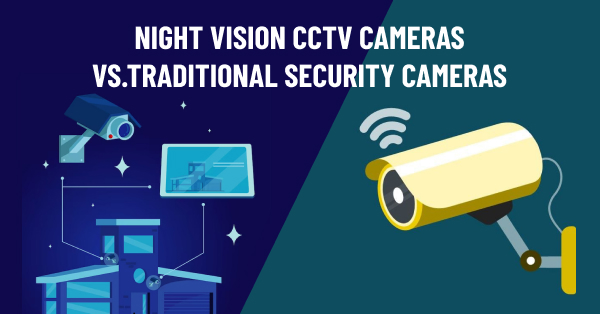
Night Vision Vs Traditional CCTV Cameras | Secure by CCTV
Explore the difference between night vision CCTV cameras and traditional security cameras. Find out which one suits your surveillance needs best!
Introduction
Security cameras have become increasingly important in a constantly changing world where safety and security are top priorities. These observant eyes are useful tools for monitoring and preventing crime and acting as a deterrent to possible threats. The need for sophisticated features like night vision has led to the evolution of security cameras, which now offer 24/7 protection. These cameras’ night vision features allow them to take crisp pictures and videos even in total darkness or low light, improving identification and visibility. Security cameras with night vision are essential for monitoring public spaces, businesses, and residential properties. Their significance cannot be emphasized enough. They enable people and institutions to monitor things, guaranteeing security and fostering comfort closely.
Camera Functions
Technology and Features
Image/Video Quality
In low light, there is a noticeable difference in the quality of the image or video between night vision CCTV cameras and regular security cameras. Conventional security cameras use inbuilt illuminators or ambient light sources, which can produce reasonable daytime or well-lit images. However, their performance degrades in dimly lit areas or in total darkness, producing grainy, hazy, or even unusable footage.
CCTV cameras with night vision, on the other hand, are excellent at taking crisp pictures and videos in dim light. These cameras are able to identify and record the infrared light that is reflected from objects in the scene by using infrared (IR) illuminators and sensitive sensors. Improved visibility and clarity are possible even in completely dark settings where conventional cameras would be unable to capture images. Effective identification of persons, objects, or activities is made possible by the sharp, detailed, and well-defined images and videos that night vision cameras frequently generate. They are especially useful for surveillance in places like parking lots, alleys, and outdoor spaces after dark when there is little to no lighting. The capacity to see well in the dark adds an extra degree of protection and guarantees that important details are not overlooked, which eventually raises the surveillance system’s overall efficacy.
Range and Coverage
The effective range and coverage area of night vision CCTV cameras and conventional security cameras are very different. Clear details at a distance or in the dark are usually difficult for traditional security cameras to capture. As the lighting worsens, their visibility may decrease significantly, leading to images that are hazy or unclear. Furthermore, the strength of the inbuilt illuminators in traditional cameras and the presence of ambient light sources frequently limit their effective range. However, night vision CCTV cameras are superior in terms of coverage and range. These cameras, which have infrared (IR) illuminators, can take better pictures even in total darkness. Their effective range is greatly increased by the infrared technology, improving visibility and image quality from a distance. In low light, night vision cameras can take crisp, high-resolution pictures and videos by using infrared light to illuminate objects within their field of vision. The ability of night vision cctv cameras to see in the dark also expands their coverage area. They can keep an eye on bigger regions without sacrificing visibility or image quality. Because of this, they are ideal for outdoor surveillance, where irregular or difficult lighting may exist.
Cost and Installation
The financial aspects related to night vision Both CCTV and conventional security cameras have upfront costs, installation requirements, and continuing maintenance requirements. Even though they are typically more expensive up front, night vision cameras have advantages like improved low-light visibility. Making an informed choice based on personal needs and financial constraints will be made easier by comprehending the precise requirements and taking long-term cost implications into account.
User-Friendliness
With differing degrees of compatibility, both conventional security cameras and CCTV cameras with night vision offer accessibility, ease of use, and minimal maintenance. A person’s specific needs will determine which option is best for them, keeping in mind factors like compatibility with current systems, maintenance requirements, remote monitoring capabilities, and user interface.
